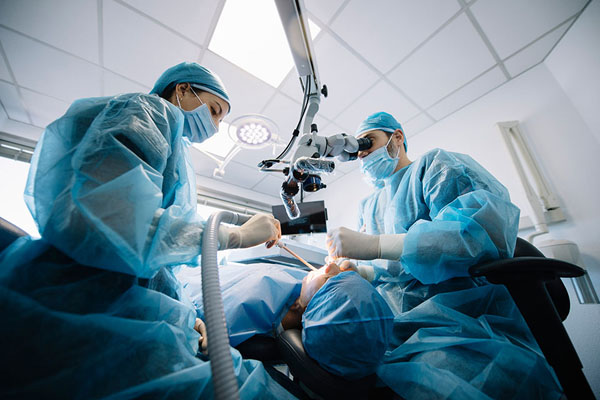Bone and Gum Grafting
Restoring Your Oral Health and Confidence With Gum Disease Treatment
As we age, our bones and gums may start to deteriorate, causing several oral health issues. Bone and gum grafting techniques are dental procedures that can help restore and maintain the health of your teeth and gums.
If you’re struggling with periodontal disease, our dentist may recommend a bone graft or gum graft to help eliminate your symptoms and get your oral health back on track. If you’re struggling with gum disease, contact our Atlanta dental office today by calling (404) 524-1981 for an appointment.
What Is Bone Grafting?
A bone graft is a surgical procedure used to replace lost or damaged tissue in the jaw caused by gum disease. A small amount of bone is taken from another part of your body, or donor source, and placed in the area of the jaw where the bone loss occurred. This procedure can prepare the jawbone for dental implants or restore bone density after tooth loss.
What Is Gum Grafting?
A gum graft is a surgical procedure used to treat gum recession caused by gum disease. It involves taking tissue from another part of your mouth, usually the roof of your mouth, and grafting it onto the receding gums. It helps cover the exposed roots of the teeth, reduces sensitivity, and improves the appearance of your smile.
Benefits of Bone and Gum Grafts
There are several benefits of using bone grafts and gum grafts for treating gum disease, including:
- Improved Oral Health: Bone and gum grafts can help restore the health of your gums and teeth, reducing your risk of tooth decay, gum disease, and other oral health problems.
- Improved Appearance: A gum graft can help cover exposed roots, improving the appearance of your smile and reducing tooth sensitivity.
- Increased Tooth Stability: Bone grafts can provide additional support for your teeth by strengthening the underlying bone tissue.
- Improved Chewing and Speaking Ability: Gum and bone grafts can restore the function of your teeth and gums, improving your ability to chew and speak normally.
- Long-Term Results: With proper care and maintenance, the results of gum and bone grafting procedures can last for many years, helping preserve the health and function of your teeth and gums.
How Grafting Procedures Work
Before the bone or gum grafting procedure, your dentist will perform a thorough examination to determine the extent of the damage and the best course of action.
Gum Grafting
Gum grafting is a surgical procedure performed by periodontists or oral surgeons to treat gum recession. Gum recession occurs when the gum tissue pulls away from the teeth, exposing the tooth roots and potentially leading to tooth sensitivity, increased risk of decay, and aesthetic concerns.
You can expect the following when receiving a gum graft:
- Anesthesia: Local anesthesia is administered to numb the area, ensuring a comfortable experience for the patient during the procedure.
- Donor tissue selection: There are three possible sources for the graft tissue: an Autograft, Allograft, or a Xenograft.
- Graft placement: The selected graft tissue is then positioned over the exposed tooth roots and stitched into place. The graft serves as a protective barrier and encourages the growth of new healthy gum tissue.
- Suturing: The surgical site is carefully sutured to ensure proper healing and stability of the gum tissue graft.
- Postoperative care: The dental professional provides instructions on how to care for the surgical site, which typically involves avoiding strenuous activities, eating soft foods, practicing proper oral hygiene, and taking prescribed medications if necessary.
- Healing process: Over time, the graft tissue integrates with the patient’s existing gum tissue and blood supply, promoting healing and restoring a healthy gum line.
Bone Grafting
Bone grafting is a surgical procedure used to repair and regenerate bone tissue. It involves taking bone from one area of the body (autograft) or using synthetic or donated bone (allograft) and transplanting it to another site where new bone growth is needed. Here’s how bone grafting works:
- Harvesting the graft material: The surgeon selects the source of the bone graft. Autografts are commonly taken from the patient’s bone, often from the hip, shin, or jaw. Alternatively, allografts can be obtained from a bone bank or created synthetically.
- Preparation of the recipient site: The area where the bone graft will be placed is prepared. The surgeon removes any damaged or dead bone and creates a suitable bed for the graft. This may involve shaping the site or creating small holes to encourage new bone growth.
- Placing the graft: The graft material is carefully positioned in the recipient site. It may be secured using screws, plates, wires, or pins, depending on the size and location of the graft. The graft serves as a scaffold for new bone to grow on.
- Healing and integration: Over time, the body’s natural healing process takes place. Initially, the graft provides a framework for blood vessels to grow into the area, supplying oxygen and nutrients. Osteoblasts, the cells responsible for bone formation, start to populate the graft, depositing new bone tissue. The graft eventually integrates with the surrounding bone, restoring strength and stability.
- Rehabilitation: After the procedure, the patient follows a rehabilitation program tailored to their specific needs. This may involve physical therapy, exercises, and restrictions on weight-bearing activities to promote healing and prevent complications.
Costs of Treatment
The costs of a bone or gum graft will vary depending on several factors, including the geographical location, the complexity of the procedure, the extent of the graft needed, and the dentist or periodontist performing the treatment. The specific materials used for the graft can also affect the overall cost.
Frequently Asked Questions
Is grafting painful?
Bone and gum grafting procedures are typically performed with a local anesthetic applied, which numbs the area and reduces any discomfort or pain during the procedure. After the procedure, patients may experience some discomfort, but this can be managed with pain medication and proper aftercare.
How long does it take to recover from bone grafts or gum grafts?
Recovery time varies depending on the extent of the procedure and the patient’s overall health. Generally, patients can expect to experience some discomfort and swelling for a few days after the procedure, and it may take several months for the transplanted tissue to fully integrate and heal.
Are there any risks associated with a bone or gum graft?
As with any surgical procedure, there are some risks associated with a bone or gum graft, such as infection, bleeding, and swelling. However, these risks can be minimized by choosing a skilled and experienced dentist who takes proper precautions and follows best practices.
Will insurance cover the cost of bone or gum grafting?
The cost of bone and gum grafting procedures can vary depending on the extent of the procedure and other factors. Some insurance plans may cover all or a portion of the cost of these procedures, but it’s important to check with your provider before the procedure to determine your coverage.
Improve Your Quality of Life With Gum Disease Treatment
Don’t let bone and gum loss rob you of your beautiful smile and oral health. Take action today by contacting our Atlanta dentist to schedule a consultation for bone and gum grafting. With his expertise and compassionate care, he can help restore your confidence and improve your quality of life.
Don’t wait any longer to take the first step towards a healthier, happier smile. Contact our dental practice today by calling (404) 524-1981.


